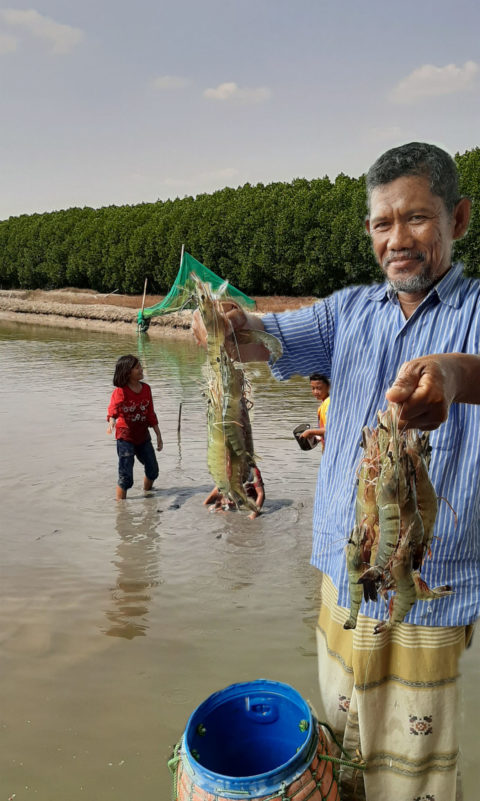
Improved Standard of Living Due to Environmentally Friendly Aquaculture
-
Coastal resilience
Abdul Ghofur, an aquaculture farmer in Tambakbulusan Village in Demak District, feels that there have been many positive changes in his economic and family life since he started implementing mangrove friendly aquaculture. Not only has his pond production increased, but it is now easier for him to market his aquaculture products at a better price to buyers in the city of Semarang who like organic food. Ghofur can now afford the schooling of his three children, the eldest of whom has almost finished university, while the second and third are in high school and junior high school.

“Thanks to the coastal field school, my milkfish and shrimp farming productivity is increasing, and of course my income is now higher. Because of this, I was able to send my child to Diponegoro University in Semarang.”
̶ Abdul Ghofur
Before implementing mangrove friendly aquaculture, Ghofur managed his ponds like most other farmers. He used conventional methods which require chemicals, just like his parents who passed the pond business to him in the late 1980s. In the beginning, this worked well, but as time went on production declined, with a low point in 2015 when production fell drastically. At that time, many of the tiger prawns that Ghofur cultivated died, and he could not solve the problem, no matter what methods he tried. In addition, the milkfish that he cultivated grew slowly and remained stunted at an age when they should have been ready for harvest.
When the Building with Nature programme was introduced in Tambakbulusan Village in 2016, Ghofur joined immediately. He was very interested in studying techniques for revitalising aquaculture through Low External Input Sustainable Aquaculture (LEISA). This was one of the activities in the Coastal Aquaculture Field schools facilitated by the programme. LEISA included composting techniques and the use of local micro-organisms that are very important for pond fertility. Ghofur applied these techniques to his pond. While his trials did not immediately succeed in increasing production, he did not give up. After several trials, he finally found the right combination of local micro-organisms and compost which he made himself. Now pond production is twice as high as before.
Ghofur has also managed to sell his farmed tiger prawns and milkfish at a price higher than the average price in the market. With the help of a network of Diponegoro University lecturers whom he knows through the Building with Nature programme, Ghofur markets his aquaculture products directly to consumers in Semarang. These consumers do not mind paying higher prices for products produced without chemicals. Such products are perceived as being safer.
Ghofur has also succeeded in diversifying his business by cultivating crabs, which he sells directly to buyers in Jakarta. He believes that the success of his pond’s production cannot be separated from the condition of the mangroves around the pond, which is now improving. Farmers who participated in the programme were required to rehabilitate mangroves on the village coast. Ghofur believes this is the right strategy.
“Healthy mangroves mean that farmers are more peaceful as they cultivate their aquaculture ponds.”
Building with Nature
From 2015 to 2021, a landscape-scale implementation of the Building with Nature approach was implemented in Demak district, Indonesia. We restored coastal and riverine mangroves to halt coastal erosion and boosted the local economy by introducing mangrove-friendly aquaculture practices. Besides engineering interventions, we engaged deeply with stakeholders to address the root causes of coastal breakdown and deliver multiple benefits to coastal communities.
Through the Bio-rights mechanism, we gave communities financial and technical support to change aquaculture methods or invest in alternative livelihoods in return for their active engagement in conservation and restoration and engaged them in village development planning.
